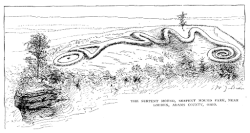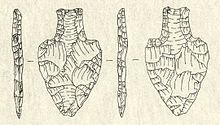
Back Каменная стадыя ў Паўночнай Амерыцы Byelorussian Ère lithique French Lithische periode Dutch Paleoindiansk tid Swedish
| Periods in North American prehistory |
|---|
 |
In the sequence of cultural stages first proposed for the archaeology of the Americas by Gordon Willey and Philip Phillips in 1958, the Lithic stage was the earliest period of human occupation in the Americas, as post-glacial hunter gatherers spread through the Americas.[1][2] The stage derived its name from the first appearance of Lithic flaked stone tools.[3] The term Paleo-Indian is an alternative, generally indicating much the same period.
This stage was conceived as embracing two major categories of stone technology: (1) unspecialized and largely unformulated core and flake industries, with percussion the dominant and perhaps only technique employed, and (2) industries exhibiting more advanced "blade" techniques of stoneworking, with specialized fluted or unfluted lanceolate points the most characteristic artifact types. Throughout South America, there are stone tool traditions of the lithic stage, such as the "fluted fishtail", that reflect localized adaptations to the diverse habitats of the continent.[4]

The indications and timing of the end of the Lithic stage vary between regions. The use of textiles, fired pottery, and start of the gradual replacement of hunter gatherer lifestyles with agriculture and domesticated animals would all be factors. End dates vary, but are around 5000 to 3000 BCE in many areas. The Archaic stage is the most widely used term for the succeeding stage, but in the periodization of pre-Columbian Peru, the Cotton Pre-Ceramic may be used. As in the Norte Chico civilization, cultivated cotton seems to have been very important in economic and power relations, from around 3200 BCE.
Archeologist Alex Krieger has documented hundreds of sites that have yielded crude, percussion-flaked tools. The most convincing evidence for a lithic stage is based upon data recovered from sites in South America, where such crude tools have been found and dated to more than 20,000 years ago.[5]
In North America, the time encompasses the Paleo-Indian period, which subsequently is divided into more specific time terms, such as Early Lithic stage or Early Paleo-Indians, and Middle Paleo-Indians or Middle Lithic stage.[6] Examples include the Clovis culture and Folsom tradition groups.
The Lithic stage was followed by the Archaic stage.
- ^ "Method and Theory in American Archaeology". Gordon Willey and Philip Phillips. University of Chicago. 1958. Archived from the original on 2012-06-28. Retrieved 2017-09-03.; free online text
- ^ Silberman, N.A.; Bauer, A.A. (2012). The Oxford Companion to Archaeology. Oxford University Press. pp. 2–151. ISBN 978-0-19-973578-5. Retrieved 2015-02-26.
- ^ Willey, Gordon R. (1989). "Gordon Willey". In Glyn Edmund Daniel; Christopher Chippindale (eds.). The Pastmasters: Eleven Modern Pioneers of Archaeology: V. Gordon Childe, Stuart Piggott, Charles Phillips, Christopher Hawkes, Seton Lloyd, Robert J. Braidwood, Gordon R. Willey, C.J. Becker, Sigfried J. De Laet, J. Desmond Clark, D.J. Mulvaney. New York: Thames & Hudson. ISBN 0-500-05051-1. OCLC 19750309.
- ^ Gordon R. Willey; Philip Phillips (1958). "Method and Theory in American Archaeology". p. 79 by. Archived from the original on 2018-03-25.
- ^ Walthall, J.A. (1990). Prehistoric Indians of the Southeast: Archaeology of Alabama and the Middle South. University of Alabama Press. p. 22. ISBN 978-0-8173-0552-9. Retrieved 2015-02-26.
- ^ Gordon R. Willey and Philip Phillips (1957). Method and Theory in American Archaeology. University of Chicago Press. ISBN 978-0-226-89888-9.
© MMXXIII Rich X Search. We shall prevail. All rights reserved. Rich X Search